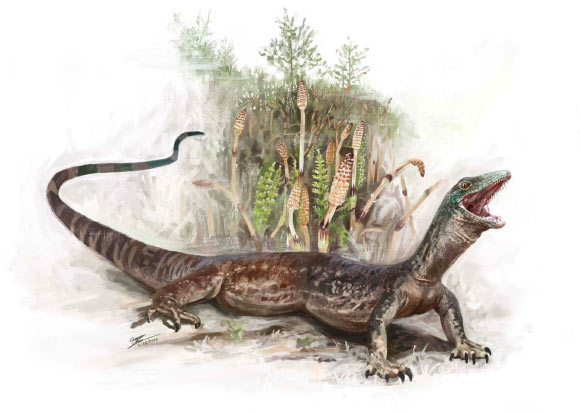Breugnathair elgolensis — a species of hook-toothed lizard that lived during the Middle Jurassic, about 167 million years ago — displays a mosaic of anatomical traits that is not present in living groups, with head and body proportions similar to monitor lizards and snake-like features of the teeth and jaws, alongside primitive traits shared with early-diverging groups such as geckos.

Life reconstruction of Breugnathair elgolensis. Image credit: Brennan Stokkermans / National Museums Scotland.
Breugnathair elgolensis is one of the oldest relatively complete fossil lizards yet discovered.
The ancient reptile had snake-like jaws and hook-like, curved teeth similar to those of modern-day pythons, paired with the short body and fully-formed limbs of a lizard.
Nearly 41 cm (16 inches) long from head to tail, it was one of the largest lizards in its ecosystem, where it likely preyed on smaller lizards, early mammals, and other vertebrates, like young dinosaurs.
“Snakes are remarkable animals that evolved long, limbless bodies from lizard-like ancestors,” said Dr. Roger Benson, Macaulay curator in the Division of Paleontology at the American Museum of Natural History.
“Breugnathair elgolensis has snake-like features of the teeth and jaws, but in other ways, it is surprisingly primitive.”
“This might be telling us that snake ancestors were very different to what we expected, or it could instead be evidence that snake-like predatory habits evolved separately in a primitive, extinct group.”
According to the paleontologists, Breugnathair elgolensis belongs to a new family of squamates (lizards and snakes), named Parviraptoridae, an enigmatic group with potential importance for snake origins, that was previously known from very incomplete remains.
“Earlier studies reported snake-like tooth-bearing bones that were found in close proximity with bones that had gecko-like features,” they said.
“But because these seemed so drastically different, some researchers believed they belonged to two different animals.”
“Our work on Breugnathair elgolensis rejects those earlier findings, showing that both snake-like and gecko-like features exist together in a single animal.”
The fossilized remains of Breugnathair elgolensis were discovered in 2016 by Stig Walsh from the National Museums Scotland on the Isle of Skye.
“The Jurassic fossil deposits on the Isle of Skye are of world importance for our understanding of the early evolution of many living groups, including lizards, which were beginning their diversification at around this time,” said Dr. Susan Evans, a paleontologist at University College London.
“I first described parviraptorids some 30 years ago based on more fragmentary material, so it’s a bit like finding the top of the jigsaw box many years after you puzzled out the original picture from a handful of pieces.”
“The mosaic of primitive and specialized features we find in parviraptorids, as demonstrated by this new specimen, is an important reminder that evolutionary paths can be unpredictable.”
A paper about the discovery of Breugnathair elgolensis was published today in the journal Nature.
_____
R.B.J. Benson et al. Mosaic anatomy in an early fossil squamate. Nature, published online October 1, 2025; doi: 10.1038/s41586-025-09566-y







